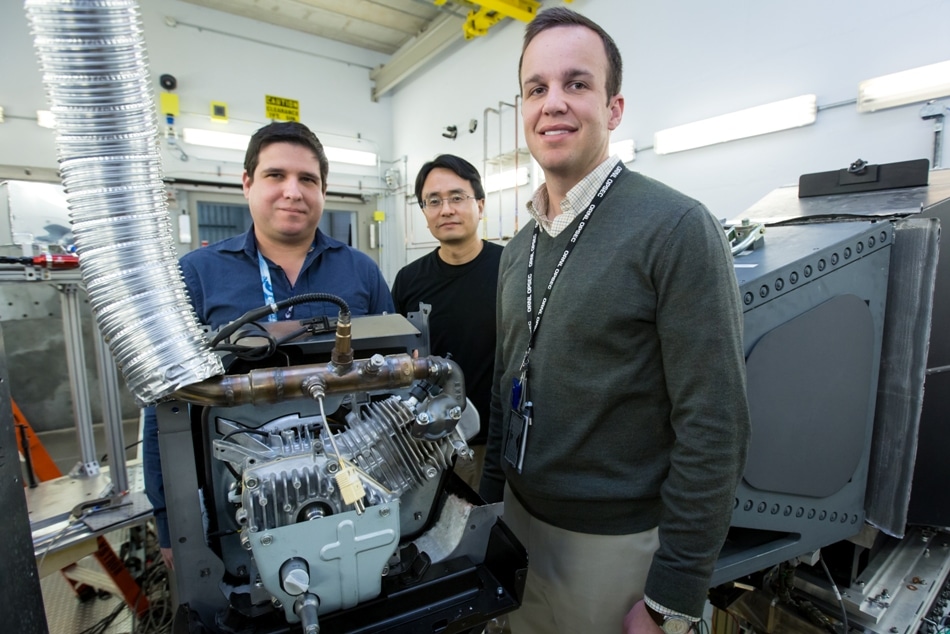Jul 27 2017
Scientists used neutrons to examine the performance of a new aluminum alloy in a gasoline-powered engine, in a first-of-a-kind experiment, while the engine was in operation.
 Researchers used neutrons to probe a running engine at ORNL’s Spallation Neutron Source, giving them the opportunity to test an aluminum-cerium alloy under operating conditions. From left, researchers Orlando Rios, Ke An, and Lt. Eric Stromme show off a cylinder head made from the new alloy. (Credit: ORNL)
Researchers used neutrons to probe a running engine at ORNL’s Spallation Neutron Source, giving them the opportunity to test an aluminum-cerium alloy under operating conditions. From left, researchers Orlando Rios, Ke An, and Lt. Eric Stromme show off a cylinder head made from the new alloy. (Credit: ORNL)
A research team from the Department of Energy’s Oak Ridge National Laboratory collaborated with industry partners to conduct the test, which studied whether a high-performance alloy that is promising for automotive applications survived under the heat and stress of an internal combustion engine.
The feat was a first for the Spallation Neutron Source, said Ke An, Chief Instrument Scientist for the facility’s VULCAN instrument. “This was the first time an internal combustion engine has been run on our diffractometer, and, as far as we know, on any other,” he stated.
The exclusive properties of neutrons allow them to enter materials in a nondestructive manner, exposing important details about a material’s atomic structure. VULCAN uses neutrons to measure stress and strain on large industrial samples, which made it perfect for assessing a cylinder head cast from an aluminum-cerium alloy ORNL built in collaboration with Eck Industries.
ORNL Materials Scientist Orlando Rios, who has been working through the Critical Materials Institute to discover the use of cerium as a strengthening agent for aluminum alloys, guided the experiment.
Our experiment confirmed that our alloy outperforms other aluminum alloys at elevated temperatures. The automotive industry is currently interested in alloys that can hold up to high-heat demands of new, energy-efficient technologies. Our aluminum-cerium composition shows exceptional stability at temperatures above 500 degrees Celsius [932 degrees Fahrenheit], which is unheard of for aluminum alloys.
Orlando Rios, Materials Scientist, ORNL
Lt. Eric Stromme, a Navy Tours with Industry Fellow who aided on the project, added, “With an aluminum alloy stable at high temperatures, engines could run hotter, and components could be made lighter, boosting efficiency and fuel economy.”
Aided by colleagues at ORNL’s Manufacturing Demonstration Facility and the National Transportation Research Center, Rios’ team cast the Al-Ce cylinder head with the help of 3D–printed sand molds and retrofitted the component to a prototype engine engineered specially for VULCAN.
During the course of the three-day experiment — with the engine halting and restarting via a remote ignition from VULCAN’s control room — neutron diffraction allowed the team to “see” the high-temperature constancy of Al-Ce during the engine’s working regime.
Materials undergo multifaceted forces and challenging temperatures during internal combustion, so the Researchers were keen to measure material performance during real operating conditions.
“We really took the engine through its paces. It was probably the loudest experiment to take place at SNS,” noted Rios, who worked on the project with ORNL Postdoc Michael Kesler and University of Tennessee Bredesen Center Fellow Zachary Sims.
The entire team was impressed by the quality of the data from VULCAN, especially given that the neutrons had to travel through an entire engine structure before being observed by our detectors to supply information on the cylinder head at work. That is truly remarkable. What we have accomplished is a proof-of-concept to prove the feasibility and value of this kind of experiment.
Orlando Rios, Materials Scientist, ORNL
An noted the efficiency of cooperating across disciplines between ORNL and industry partners to back the effort. He is presently working to simplify the process for future VULCAN users.
This was a fundamental experiment not only to better understand this alloy but also to provide some broader analysis that will allow new alloys, not only aluminum compounds, to be processed in this way. The experiment demonstrates the benefits of coupling fundamental science with early stage research and development of new materials and technologies. We hope what we are learning through this experiment can be applied to many other materials in a wide range of applications.
Orlando Rios, Materials Scientist, ORNL
This research was funded by the DOE Office of Energy Efficiency and Renewable Energy through the Critical Materials Institute, a DOE Energy Innovation Hub, with additional funding from the DOE Office of Science. Partners include Ames National Laboratory, ORNL, Lawrence Livermore National Laboratory, Idaho National Laboratory and Eck Industries. The Materials Science and Technology Division at ORNL guided the experiment in partnership with the Manufacturing Demonstration Facility, National Transportation Research Center and the VULCAN instrument team.
The Spallation Neutron Source is a DOE Office of Science User Facility. UT-Battelle manages ORNL for the DOE Office of Science. The single biggest supporter of rudimentary research in the Physical Sciences in the United States, the Office of Science aims to look into some of the most pressing challenges of current times.
The Manufacturing Demonstration Facility and the National Transportation Research Center are DOE EERE User Facilities supported by EERE’s Advanced Manufacturing Office and Vehicle Technologies Office, respectively.
The Critical Materials Institute is a Department of Energy Innovation Hub operated by Ames Laboratory for DOE and supported by EERE’s Advanced Manufacturing Office. CMI seeks to guarantee supply chains of rare earth elements and other materials essential for clean energy technologies — enabling modernization in U.S. manufacturing and enhancing U.S. energy security.
Neutrons peer into a running engine